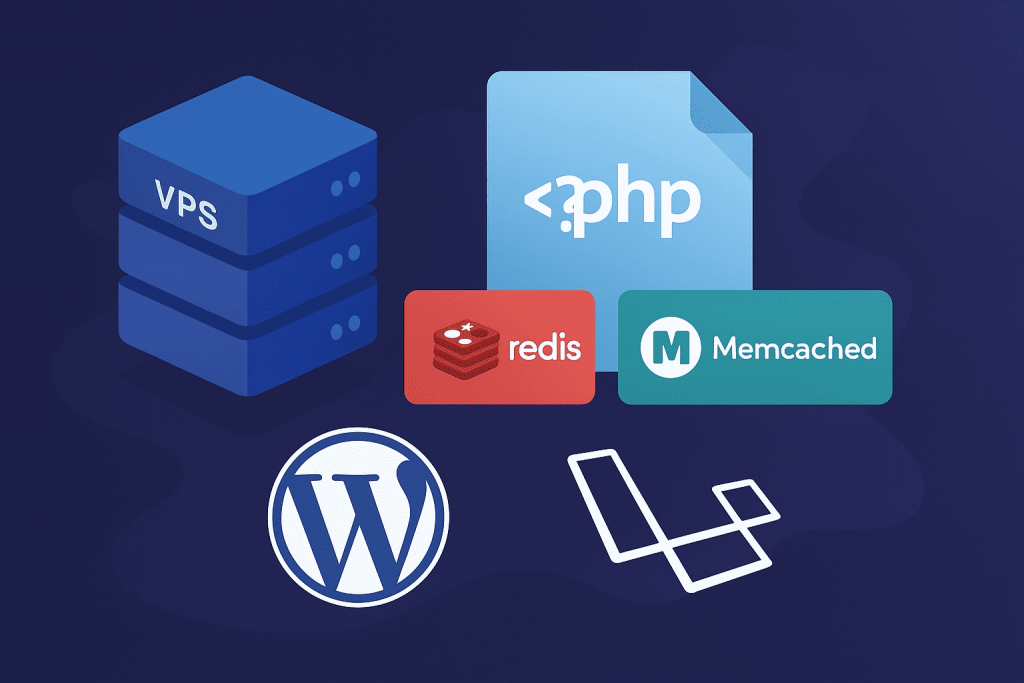
Website speed is a critical factor for both search engine rankings and user experience. The longer a page takes to load, the more likely a visitor is to leave the site. That’s why performance optimization has become an essential step for any web project. This is especially true for popular PHP frameworks like WordPress and Laravel, which rely heavily on database interactions.
One of the most effective ways to speed up PHP-based websites is through KV optimization — using key‑value (KV) data stores to implement caching and reduce load on the database. In this article, we’ll explain how KV caching works, how to set it up on your own VPS, and how it can significantly improve the performance of your WordPress or Laravel project.
What is KV Optimization?
KV (Key‑Value) is a data structure that stores information in a “key — value” format and allows for extremely fast data retrieval. Unlike traditional relational databases, KV stores operate in memory and are ideal for caching.
The most common KV stores include:
- Redis
- Memcached
- APCu (for local, in-process PHP caching)
In PHP applications, KV optimization involves saving the results of heavy operations (like SQL queries, template rendering, or complex calculations) in a cache, reducing response time and server load.
Why It’s Especially Important on VPS
With shared hosting, you split resources with other users. But when you rent a VPS, you get full control over dedicated resources such as CPU, RAM, and disk space. This allows you to install Redis or Memcached, fine-tune caching parameters, and manage your caching strategy according to your project’s needs.
On a VPS, you can also:
- Use Redis for session storage instead of file-based sessions.
- Create separate caches for different sites or services.
- Enable Redis persistence to preserve cached data after reboots.
KV Caching in WordPress: A Simple Way to Boost Speed
WordPress is one of the most resource-intensive CMSs, especially when loaded with plugins. Even a basic page may trigger dozens of SQL queries. To avoid this:
1. Use plugins with Redis or Memcached support:
- Redis Object Cache
- W3 Total Cache
- LiteSpeed Cache (works well with Memcached)
These plugins intercept database queries and store results in a KV store.
2. Enable full-page caching:
W3 Total Cache, for example, can save entire HTML pages, allowing the server to serve them instantly without invoking PHP.
3. Cache user sessions:
WordPress can store session data in Redis, reducing disk I/O and database load.
Laravel + Redis = A Perfect Pair
Laravel natively supports Redis as a caching layer, session store, queue system, and even as an event broadcasting broker.
php
// config/cache.php
'default' => env('CACHE_DRIVER', 'redis');
Key use cases:
- Configuration caching:
bash
php artisan config:cache
- Route caching:
bash
php artisan route:cache
- Query result caching:
php
Cache::remember(‘users’, 60, function () {
return DB::table(‘users’)->get();
});
- Queues and broadcasting:
Laravel’s queue worker works seamlessly with Redis for asynchronous task processing.
Recommendations:
- Install phpredis or predis extensions for Redis integration.
- Use separate Redis instances for caching, sessions, and queues when needed.
KV Optimization and Security
Don’t forget that Redis and Memcached listen on open TCP ports. In production environments:
- Restrict access with bind 127.0.0.1
- Set a password (requirepass)
- Use an SSL tunnel or VPN if external access is necessary
It’s also a best practice to place Redis behind a private network inside your VPS and avoid exposing it to the public.
Additional VPS Performance Tips
- Install and configure OPcache to reduce PHP file compilation time.
- Use APCu for storing in-process variables locally.
- Monitor Redis memory usage: use TTLs for cache entries and regularly clean up expired keys.
- For high-traffic projects, it’s best to host your server in a data center with NVMe storage and high network bandwidth.
Conclusion
KV optimization is not just a technical trick — it’s one of the most effective ways to accelerate your website. Leveraging Redis, Memcached, or APCu along with a properly configured server can significantly reduce database load, speed up response times, and improve the overall user experience.
With your own VPS, you gain full control over these optimizations — so don’t miss the opportunity to supercharge your web projects.
Need full control over performance? Choose a VPS server with full root access and implement KV optimization to the fullest. Speed is the first thing users notice — and the last thing they forget.

Leave a Reply